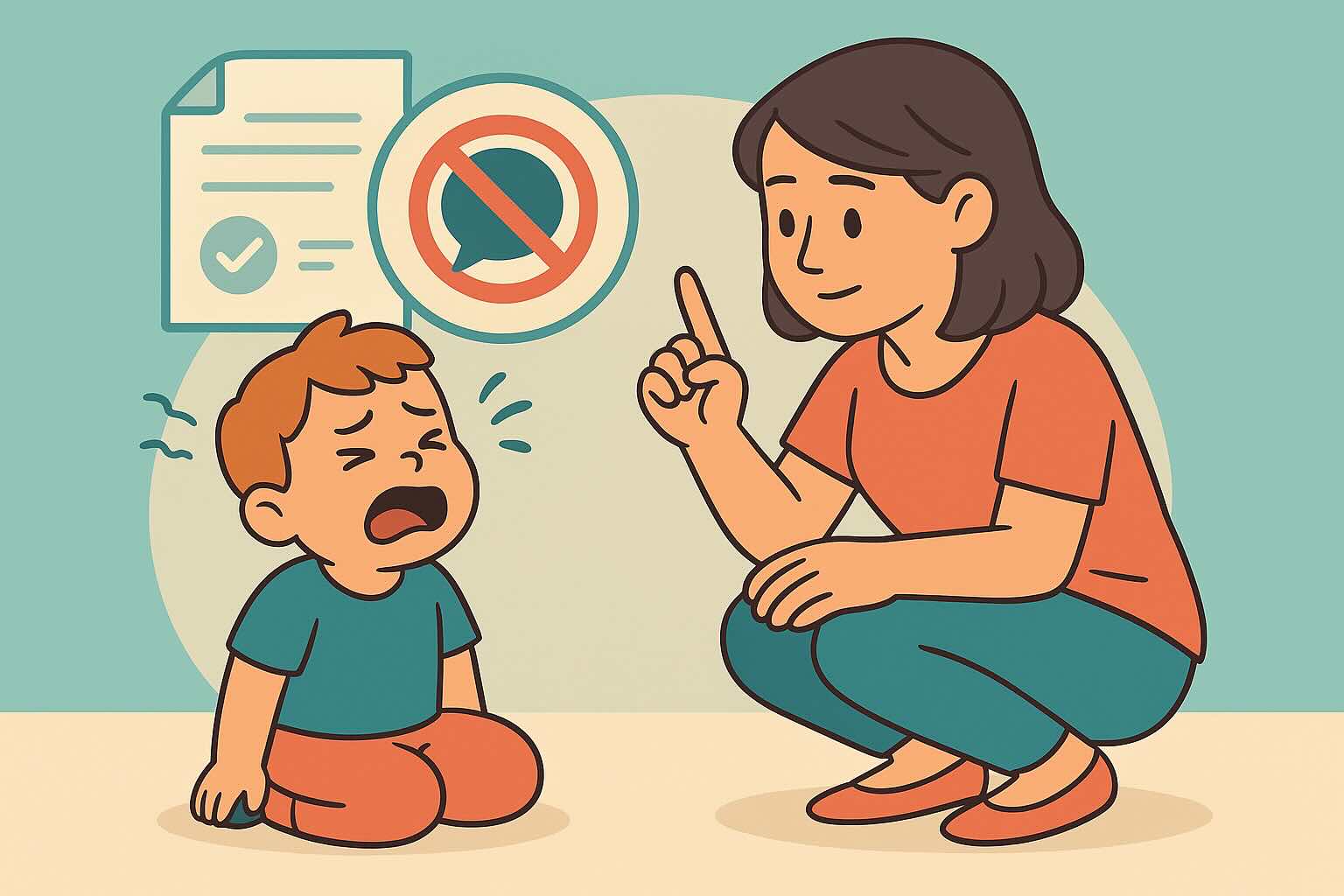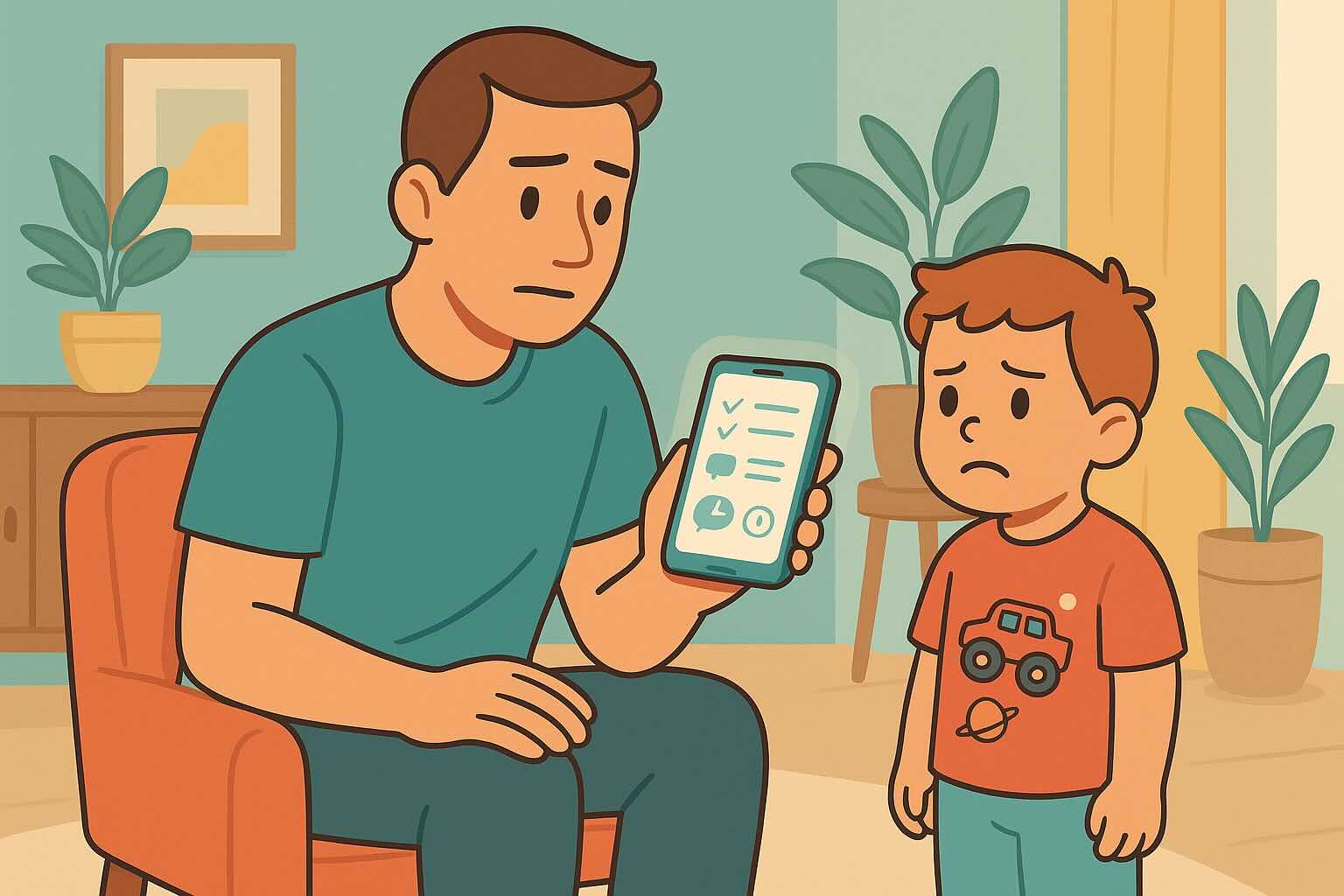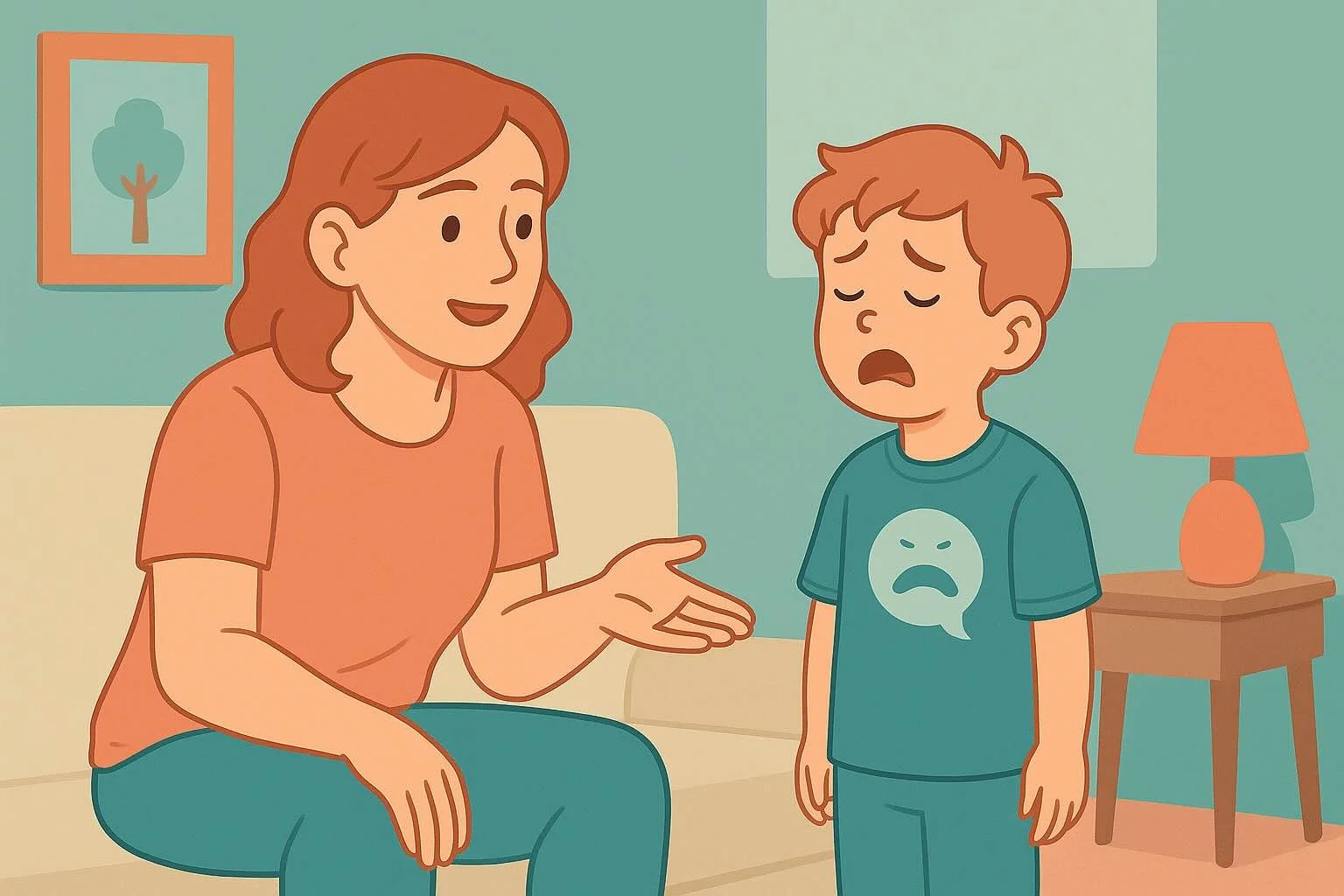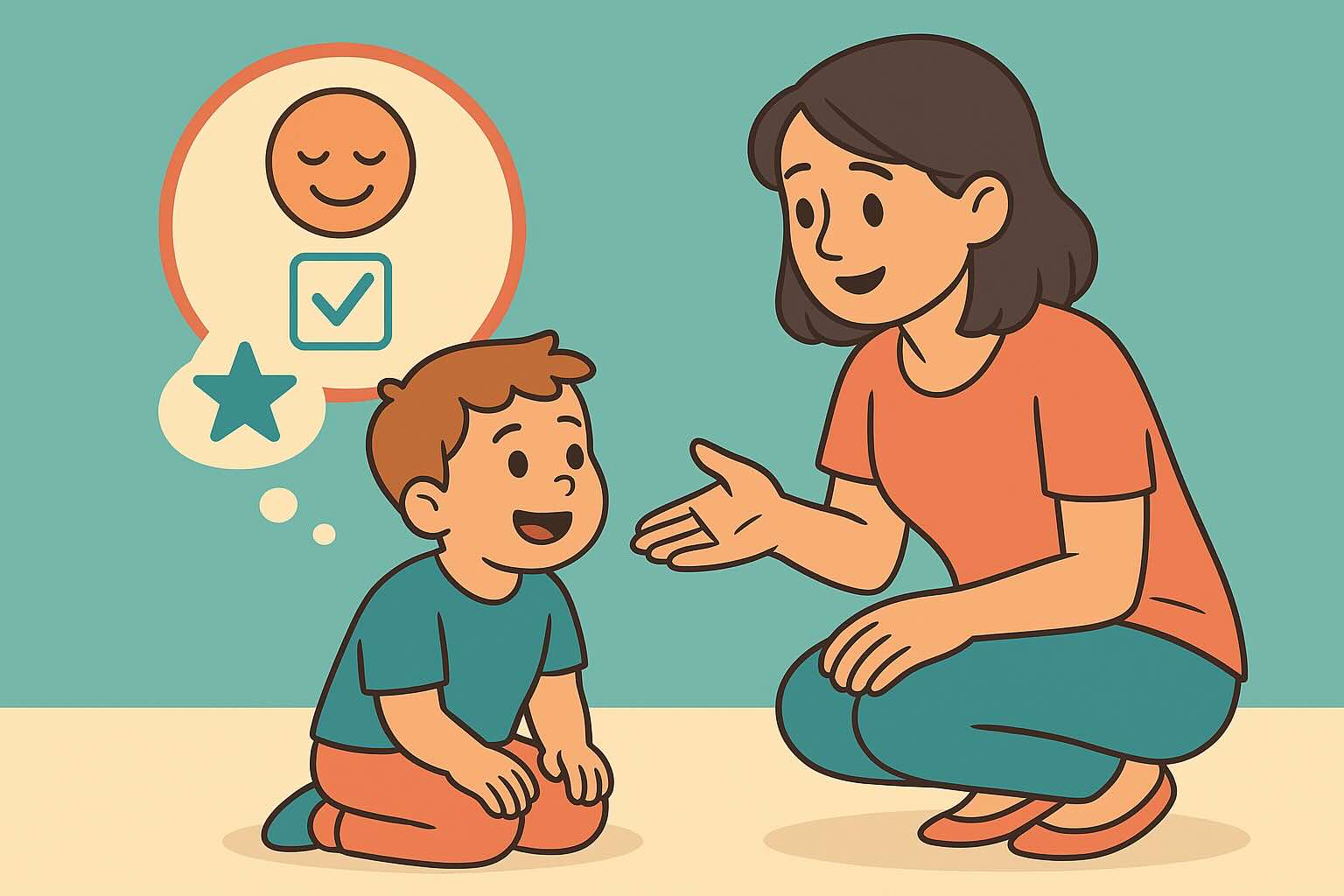How to Stop Child Whining: 4 Techniques That Work for 90% of Families


If you've ever found yourself saying "I can't understand you when you whine" while secretly wanting to hide in the bathroom, you're not alone. Whining affects 95% of families with children ages 3-7, and it's one of the most triggering behaviors parents face. The high-pitched, demanding tone can make even the most patient parent feel frustrated and overwhelmed.
Here's the truth: some whining is actually normal. Children need to vent sometimes, just like adults. But when whining becomes your child's primary communication method—when their regular voice seems to have disappeared entirely—it's time for a strategic approach.
This comprehensive guide provides evidence-based strategies specifically for children ages 3-7, with realistic timelines and practical scripts that work for 90% of families within 4-6 weeks. For age-specific approaches, see our age-specific whining strategies, and for prevention techniques, check our whining prevention guide. If whining is part of broader behavioral challenges, also explore our managing power struggles guide and connection before correction approach.
What You'll Learn in This Guide
- Why Children Whine - The real reasons behind whining behavior and when it's normal vs. problematic
- The 3-C Method - Calm, Composed, Consistent responses that actually work
- Age-Specific Strategies - Different approaches for 3-4 year olds vs. 5-7 year olds
- Prevention Techniques - How to reduce whining before it starts
- Practical Scripts - Exactly what to say in every whining situation
- Handling Different Types - From helpless whining to angry whining
- Realistic Timeline - What to expect week by week during the change process
Estimated reading time: 12 minutes
Understanding Why Children Whine (Ages 3-7)
The Psychology Behind Whining Behavior
Whining is indirect communication—your child wants something but hasn't learned to express it directly and clearly. Instead of saying "I'm bored and would like something to do," they whine "There's nothing to dooooo" in that distinctive tone that makes your teeth clench.
Why whining develops:
- It works: Whining often gets bigger reactions and sometimes the desired outcome
- Emotional overwhelm: Children lack the skills to manage frustration effectively
- Attention-seeking: Even negative attention feels better than being ignored
- Limited vocabulary: They feel big emotions but lack words to express them appropriately
- Learned behavior: They've observed that whining gets results (even if inconsistently)
Normal vs. Problematic Whining
Normal whining (occasional venting):
- Happens 1-2 times per week during stressful moments
- Lasts 2-5 minutes and child can be redirected
- Child still uses regular voice for most communication
- Occurs during specific triggers (tiredness, hunger, transitions)
- Child responds to calm redirection
Problematic whining (needs intervention):
- Becomes the primary communication method for requests
- Happens multiple times daily for routine interactions
- Child's regular voice rarely appears
- Whining escalates when not immediately addressed
- Child cannot be easily redirected to normal communication
Age-Specific Whining Patterns
Ages 3-4: The "Testing" Phase
- Whining peaks as children test boundaries and communication methods
- Often combined with other challenging behaviors (tantrums, defiance)
- Limited vocabulary makes direct communication more difficult
- Responds well to simple, consistent approaches
Ages 5-7: The "Strategic" Phase
- More sophisticated whining that targets specific outcomes
- Children understand cause and effect better
- Can engage in more complex conversations about communication
- May use "helpless" whining to manipulate situations
The 3-C Method: Your Foundation for Success
The most powerful tools for addressing whining are your three Cs: Calm, Composed, and Consistent. This approach requires a plan and emotional preparation, but it's the foundation that makes everything else work.
C #1: Stay Calm (Manage Your Own Emotions)
Why this matters: If you're triggered by whining, you'll give the big emotional reaction that reinforces the behavior. Your calm demeanor teaches your child that whining doesn't create drama or urgency.
Practical strategies:
- Prepare yourself mentally with a mantra: "This is a moment in time, not forever"
- Take three deep breaths before responding
- Lower your voice intentionally when you hear whining
- Remind yourself: "I am my child's guide, not their emotional reactor"
C #2: Stay Composed (Don't Give Big Reactions)
Why this matters: Big reactions—whether positive or negative—reinforce whining behavior. Children repeat behaviors that get strong responses.
What NOT to do:
- "I can't hear you when you whine!" (dishonest and lacks guidance)
- "Stop whining right now!" (shows your frustration without teaching)
- Immediately giving in to stop the whining (reinforces the behavior)
- Getting visibly frustrated or angry (provides the emotional reaction they're seeking)
C #3: Stay Consistent (Respond the Same Way Every Time)
Why this matters: Inconsistency teaches children to keep trying whining because "sometimes it works." Consistency helps children learn new patterns faster.
Consistency requirements:
- Use the same language and tone every time
- Don't give in "just this once" when you're tired or embarrassed
- Apply the same approach whether at home or in public
- Ensure all caregivers use the same method
Step-by-Step Method to Stop Whining
Phase 1: The Reflective Conversation (During Calm Moments)
Before addressing whining in the moment, have this important conversation when everyone is calm and connected.
Step 1: Narrate and Reflect "I've been noticing there's been a lot of whining lately. Do you know what whining is? It's when you want to tell me something or show me how you feel, and instead of using your regular voice, you're using a whining voice."
Step 2: Role-Play and Demonstrate "Let's practice! Show me your whining voice... now show me your regular voice. Can you hear the difference?"
Make this playful and take turns. Even 6-7 year olds enjoy this exercise and benefit from the clear demonstration.
Step 3: Validate and Set Boundaries "I know that whining might feel good sometimes, but it's not the way to tell me what you need. I always want to hear you, and I want to hear your regular voice—even when you're upset. That's what we're going to practice."
Step 4: Explain the New Plan "When you tell me something in a whining voice, I'm going to say 'I hear your whining. Can you hear it too? Tell me again in your regular voice.' It might take time to get used to, and that's okay. I know you can do it."
Phase 2: In-the-Moment Response Strategy
When your child whines, use this consistent approach:
Step 1: Acknowledge Calmly "I hear your whining. I hear it loud and clear. Can you hear it too?"
Step 2: Redirect to Regular Voice "Tell me again anything you want in your regular voice."
Step 3: Provide Modeling (If Needed) "In your regular voice, say 'Can I have some water?' or 'I'm feeling bored.'"
Step 4: Encourage and Wait "You can do it. Try again in your regular voice. I want to hear you."
Step 5: Set Boundary for Persistence If whining continues: "When you're all done whining, you can tell me in your regular voice anything you want. I'm right here when you're ready."
Phase 3: Handling Different Whining Scenarios
Scenario 1: Basic Request Whining Child whines: "I want a snaaaack"
Your response: "I hear your whining. In your regular voice, say 'May I please have a snack?'"
Scenario 2: Emotional Whining Child whines: "You never let me do anythiiiiing"
Your response: "I hear your whining. I think you want to tell me you're frustrated. Tell me in your regular voice: 'I'm disappointed that I can't do what I want.'"
Scenario 3: Helpless Whining Child whines: "Please, it's not faaaair"
Your response: "I hear your whining. Remember, whining doesn't change my answer. You can tell me 'I don't like your decision' in your regular voice, and I'll listen."
Age-Specific Strategies and Scripts
Ages 3-4: Simple and Concrete Approaches
Key principles:
- Use shorter sentences and simpler concepts
- Provide more modeling and demonstration
- Expect more repetition and patience
- Focus on basic "regular voice" vs. "whining voice" distinction
Effective scripts for 3-4 year olds:
- "Show me your big kid voice"
- "Use your strong voice to tell me"
- "I listen to regular voices, not whining voices"
- "Try again with your nice voice"
Common challenges and solutions:
- Limited vocabulary: Provide the exact words they can use
- Emotional overwhelm: Acknowledge feelings before addressing communication
- Shorter attention span: Keep interactions brief and focused
Ages 5-7: More Sophisticated Communication
Key principles:
- Engage in conversations about communication effectiveness
- Address the "strategy" behind whining more directly
- Expect higher standards for self-regulation
- Connect whining to broader social and emotional learning
Effective scripts for 5-7 year olds:
- "I notice you're using a whining voice. What are you trying to tell me?"
- "Whining doesn't help me understand what you need"
- "You have so many clear words you can use. Show me!"
- "I think you know what to do. Try again, please."
Advanced strategies:
- Problem-solve together about better communication methods
- Discuss how whining affects relationships with friends and family
- Connect to school expectations for appropriate communication
- Teach self-awareness: "Can you hear your whining voice?"
Prevention Strategies: Reducing Whining Before It Starts
Environmental and Routine Modifications
Create communication-friendly environments:
- Establish regular one-on-one attention time
- Use visual schedules to reduce uncertainty and frustration
- Maintain consistent daily routines that meet basic needs
- Create "connection before correction" moments throughout the day
Proactive attention strategies:
- Give positive attention for appropriate communication
- Notice and praise when children use their "regular voice"
- Provide choices within acceptable boundaries
- Address basic needs (hunger, tiredness, overstimulation) proactively
Teaching Emotional Vocabulary
During calm moments:
- Read books about feelings and emotions
- Practice expressing frustration appropriately: "I'm disappointed that..."
- Teach difference between feelings and demands
- Model your own emotional expression: "I'm feeling frustrated, so I'm going to take three deep breaths"
Emotional regulation skills:
- Practice taking deep breaths when upset
- Create a "feelings thermometer" to identify emotional intensity
- Teach the difference between "big feelings" and "whining voice"
- Practice asking for help: "Can you help me with..." instead of whining
Realistic Timeline: What to Expect Week by Week
Week 1-2: Initial Implementation
What to expect:
- Whining may initially increase (extinction burst)
- Child will test your consistency
- You'll need to repeat the process many times
- Focus on staying calm and consistent
Your goals:
- Have the reflective conversation
- Start using consistent language
- Practice role-playing during calm moments
- Track patterns and triggers
Week 3-4: Pattern Recognition
What to expect:
- Child begins to recognize their whining voice
- Some improvement in cooperation, but still testing
- Occasional "regular voice" responses
- You feel more confident with the approach
Your goals:
- Maintain consistency even when tired or stressed
- Begin shorter responses: "Regular voice, please"
- Celebrate small improvements
- Address any caregiver inconsistencies
Week 5-6: Significant Improvement
What to expect:
- 60-70% reduction in whining frequency
- Child self-corrects sometimes without prompting
- Faster transitions from whining to regular voice
- Family stress levels decrease noticeably
Your goals:
- Fine-tune approach based on what's working
- Begin expecting more independence: "I think you know what to do"
- Continue positive reinforcement for appropriate communication
- Plan for challenging situations (public places, tired moments)
Week 7-8+: Maintenance and Mastery
What to expect:
- Whining becomes occasional rather than habitual
- Child uses regular voice as primary communication method
- Quicker resolution when whining does occur
- Improved family communication overall
Your goals:
- Maintain consistency during developmental regressions
- Continue teaching advanced communication skills
- Model healthy emotional expression
- Celebrate the transformation in family dynamics
Handling Specific Whining Challenges
The "Helpless" Whining Child
Common phrases:
- "You never let me..."
- "It's not fair..."
- "Please, please, please..."
- "I never get anything..."
Effective response strategy: "I hear your whining. I know it's hard when you don't get what you want. Whining doesn't change my answer, but you can tell me you're disappointed in your regular voice."
Address the underlying belief: During calm moments: "I have a feeling you think whining is the way to get me to say yes. That's not how it works. Sometimes my answer is yes, sometimes it's no, but whining won't change it."
For comprehensive strategies for handling manipulative "helpless" whining patterns, see our detailed helpless whining guide. When whining escalates to tantrum behaviors, refer to our toddler tantrum management guide.
Public Place Whining
Preparation strategies:
- Practice the method at home first
- Have a plan for difficult locations (grocery stores, restaurants)
- Bring distractions and snacks for prevention
- Remind yourself that consistency in public is crucial
In-the-moment approach: Use the same calm language, possibly moving to a quieter area if needed. Don't give in due to embarrassment—this teaches children that public whining is more effective.
Whining During Transitions
Common triggers:
- Leaving preferred activities
- Starting non-preferred activities
- Changes in routine or plans
- Time pressure situations
Prevention and response:
- Give transition warnings: "In 5 minutes, we'll need to leave"
- Validate the difficulty: "It's hard to stop playing"
- Use the same whining response while acknowledging the transition challenge
- Create transition rituals that reduce stress
When Professional Support Might Help
Signs That Additional Support Could Be Beneficial
- Whining continues at the same intensity after 8-10 weeks of consistent implementation
- Child shows signs of anxiety or depression alongside whining
- Whining is accompanied by aggressive behaviors or extreme meltdowns
- Family functioning is significantly impacted despite consistent efforts
- Child shows difficulty with communication in multiple settings (school, social situations)
- Underlying developmental or learning differences may be contributing
Types of Professional Support
Speech-language pathologists can help with communication skill development Child psychologists can address underlying emotional or behavioral patterns Occupational therapists can help with sensory processing issues that may contribute to communication difficulties Family therapists can provide support for family dynamics and communication patterns
Success Stories: Real Families' Experiences
Maria's Story: The Persistent Whiner
"My 4-year-old Sofia whined about everything—from getting dressed to what was for dinner. I was so embarrassed in public and exhausted at home. After implementing the 3-C method consistently for about 5 weeks, the change was remarkable. She still whines occasionally when she's really tired, but it's her exception, not her rule. The role-playing during calm moments was a game-changer—she actually started catching herself and saying 'Oops, let me use my regular voice.'"
David's Story: The Strategic Whiner
"My 6-year-old Alex had figured out that certain types of whining worked better in different situations. He was incredibly strategic about it. Once I addressed the 'helpless whining' directly and stopped changing my answers based on his complaints, everything shifted. It took about 8 weeks because he really tested my consistency, but now he's one of the most direct communicators in our family."
Jennifer's Story: The Public Whining Challenge
"Emma would save her worst whining for grocery stores and restaurants. I was giving in just to avoid the embarrassment. Once I realized I was teaching her that public whining was more effective, I committed to consistency everywhere. The first few public outings were rough, but after about a month, she completely stopped the public whining strategy. Now shopping is actually pleasant again."
Your 6-Week Action Plan
Week 1: Foundation Setting
- Have the reflective conversation during a calm moment
- Start role-playing whining vs. regular voice
- Begin using consistent language when whining occurs
- Track whining patterns and your emotional responses
Week 2: Consistency Building
- Continue with the same responses every time
- Don't give in when you're tired or stressed
- Practice staying calm during extinction bursts
- Ensure all caregivers are using the same approach
Week 3: Refinement
- Shorten your responses as child learns the pattern
- Add encouragement and celebration for appropriate communication
- Address specific whining triggers you've identified
- Stay patient during the learning process
Week 4: Expansion
- Apply the method in different settings (public, visiting family)
- Begin expecting more independence in self-correction
- Continue positive reinforcement for regular voice usage
- Fine-tune approach based on what's working best
Week 5: Mastery Building
- Use brief prompts: "Regular voice, please" or "Try again"
- Celebrate significant improvements and progress made
- Begin teaching more advanced communication skills
- Maintain consistency during any temporary setbacks
Week 6: Long-term Success
- Focus on maintenance and occasional reinforcement
- Address any remaining challenging situations
- Continue modeling healthy emotional expression
- Plan for handling future developmental phases
Key Takeaways: Your Whining Management Toolkit
- ✅ Some whining is normal but shouldn't become the primary communication method
- ✅ The 3-C method (Calm, Composed, Consistent) is your foundation for success
- ✅ Role-playing during calm moments helps children recognize voice differences
- ✅ Don't ignore whining—acknowledge it and redirect to appropriate communication
- ✅ Expect temporary increases in whining when you first change your responses
- ✅ Consistency in all settings is crucial for lasting change
- ✅ 4-6 weeks of consistent implementation shows significant improvement for most families
- ✅ Address "helpless whining" by clarifying that whining doesn't change decisions
- ✅ Prevention through connection and routine reduces whining triggers
- ✅ Professional support is available if needed after consistent implementation
Remember: You're not just stopping whining—you're teaching your child effective communication skills that will serve them throughout their life. Clear, direct communication is essential for healthy relationships, academic success, and emotional well-being. These communication foundations also support managing other challenging behaviors like building cooperation without rewards and addressing dishonesty concerns.
This approach is based on child development research and proven behavioral strategies. Individual results may vary based on child temperament, family consistency, and implementation quality. Understanding your child's unique personality can help tailor these approaches. Consult with professionals if concerns persist or if underlying developmental issues are suspected.
Challenging Moments Support
Access step-by-step parenting strategies, quick tips, and age-specific guidance for difficult situations when you need it most.

Complete Whining Response Scripts
Calm, effective responses to all types of whining behavior in children ages 3-7.
Frequently Asked Questions
Need personalized support?
RootWise's AI coach can provide tailored strategies for your specific situation, available 24/7 when you need it most.
Learn More About AI Coaching →



